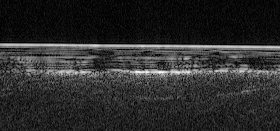Σε
ρευστή μορφή κάτω από τους πάγους. Τα ευρήματα της Ευρωπαϊκής Υπηρεσίας
Διαστήματος συνιστούν την πρώτη απόδειξη πως υπάρχει σώμα υγρού ύδατος κάτω από
την επιφάνεια. Mars' south polar cap and Hellas Basin are visible in
this image, taken with the European Space Agency's Mars Express orbiter. Credit: ESA/DLR/FU Berlin
Μια
τεράστια λίμνη κάτω από τον πάγο ανακαλύφθηκε στον Άρη. Μέχρι σήμερα δεν είχε
βρεθεί τόσος όγκος νερού σε υγρή μορφή
που εικάζεται ότι είναι απαραίτητη προϋπόθεση για την ανάπτυξη της ζωής,
ανακοίνωσε την Τετάρτη μία διεθνής ομάδα αστρονόμων.
Ο
εντοπισμός της υπόγειας λίμνης του Άρη είναι από μόνη της μια σπουδαία
ανακάλυψη η οποία φυσικά θα πάρει ιστορικές διαστάσεις αν εντοπιστεί εκεί η
ύπαρξη ζωής. ESA’s Mars Express has used radar signals bounced
through underground layers of ice to find evidence of a pond of water buried
below the south polar cap. A subsurface radar profile is shown in the right
hand panel for one of the Mars orbits. The bright horizontal feature at the top
represents the icy surface of Mars in this region. The south polar layered
deposits – layers of ice and dust – are seen to a depth of about 1.5 km. Below
is a base layer that in some areas is even much brighter than the surface
reflections, highlighted in blue, while in other places is rather diffuse.
Analysing the details of the reflected signals from the base layer yields
properties that correspond to liquid water. Credit: Context map: NASA/Viking;
THEMIS background: NASA/JPL-Caltech/Arizona State University; MARSIS data:
ESA/NASA/JPL/ASI/Univ. Rome; R. Orosei et al 2018
Η
λίμνη, που βρίσκεται κάτω από ένα στρώμα αρειανού πάγου, έχει διάμετρο περίπου
20 χλμ. και το σχήμα ενός στρογγυλεμένου τριγώνου, δημιουργεί την ελπίδα για
την παρουσία και άλλου νερού, ακόμη και ζωής, στον κόκκινο πλανήτη, σύμφωνα με
άρθρο που δημοσιεύεται στην αμερικανική επιθεώρηση Science.
Η
θερμοκρασία της λίμνης εικάζεται πως είναι σαφώς κάτω από το επίπεδο πήξης του
νερού όμως η ESA πιστεύει ότι υπάρχουν αλατώδη ιζήματα που επιτρέπουν το νερό
να παραμένει σε υγρή μορφή.
Ο
κύριος ερευνητής του προγράμματος ραντάρ MARSIS της ESA, Ρομπέρτο Οροσέι,
σημείωσε ότι είναι πιθανό να υπάρχει υγρό νερό και σε άλλες περιοχές του
Κόκκινου Πλανήτη.
ESA’s Mars Express
has used radar signals bounced through underground layers of ice to identify a
pond of water buried below the surface. This image shows an example radar
profile for one of 29 orbits over the 200 x 200 km study region in the south
polar region of Mars. The bright horizontal feature at the top corresponds to
the icy surface of Mars. Layers of the south polar layered deposits – layers of
ice and dust – are seen to a depth of about 1.5 km. Below is a base layer that
in some areas is even much brighter than the surface reflections, while in
other places is rather diffuse. The brightest reflections from the base layer –
close to the centre of this image – are centred around 193°E/81°S in all
intersecting orbits, outlining a well-defined, 20 km wide subsurface anomaly
that is interpreted as a pond of liquid water. Credit: ESA/NASA/JPL/ASI/Univ.
Rome; R. Orosei et al 2018
«Είναι ένα εκπληκτικό αποτέλεσμα που μας
κάνει να σκεφθούμε πως η παρουσία νερού στον Άρη δεν είναι μόνο μια προσωρινή
ροή όπως έχουν δείξει προηγούμενες ανακαλύψεις, αλλά μια μόνιμη μάζα νερού που
δημιουργεί συνθήκες για τη ζωή σε μια παρατεταμένη χρονική περίοδο»
σχολίασε ο Άλαν Ντάφι, επίκουρος καθηγητής του Πανεπιστημίου Σούινμπερν
(Αυστραλία), ο οποίος δεν συμμετείχε στη μελέτη.
Στην
ανακοίνωσή της η Υπηρεσία σημείωσε πως η ανακάλυψη θυμίζει την λίμνη Βοστόκ,
που είχε βρεθεί 4 χιλιόμετρα κάτω από τον πάγο στην Ανταρκτική, σημειώνοντας
ότι κάποιες μορφές μικροβιακής ζωής επιβιώνουν σε οικοσυστήματα κάτω από τον
πάγο.
The ExoMars Trace Gas Orbiter captured this view of part of the south polar ice cap on Mars on 13 May 2018. The poles of Mars have huge ice caps that are similar to Earth’s polar caps in Greenland and Antarctica. These caps are composed primarily of water ice and were deposited in layers that contain varying amounts of dust. They are referred to as the martian Polar Layered Deposits (PLD). Thanks to massive canyons that dissect the layered deposits, orbiting spacecraft can view the layered internal structure. The ExoMars orbiter’s Colour and Stereo Surface Imaging System, CaSSIS, viewed this 7 x 38 km segment of icy layered deposits near the margin of the South PLD, which extend as far north as 73ºS. Here, CaSSIS has imaged remnant deposits within a crater at this margin. The beautiful variations in colour and brightness of the layers are visible through the camera’s colour filters. It highlights the bright ice and the redder sandy deposits toward the top of the image. Credit: ESA/Roscosmos/CaSSIS , CC BY-SA 3.0 IGO
Ο πλανήτης Άρης είναι παγωμένος, ερημικός και άνυδρος αλλά προηγουμένως ήταν ζεστός και υγρός και φιλοξενούσε μια μεγάλη ποσότητα νερού σε υγρή μορφή και λιμνών πριν από τουλάχιστον 3,6 δισεκ. χρόνια.
Πηγές: http://science.sciencemag.org/content/early/2018/07/24/science.aar7268 - http://www.esa.int/Our_Activities/Space_Science/Mars_Express/Mars_Express_detects_liquid_water_hidden_under_planet_s_south_pole - http://www.tovima.gr/science/article/?aid=1007960




Δεν υπάρχουν σχόλια:
Δημοσίευση σχολίου